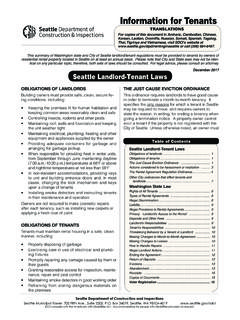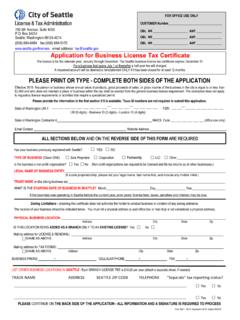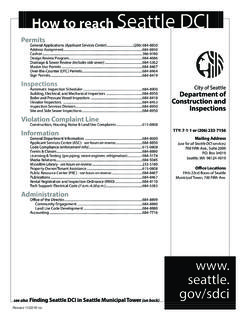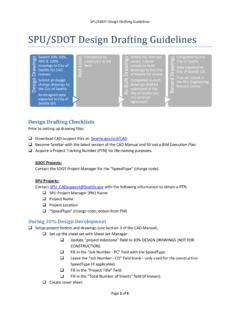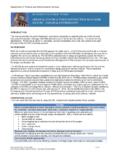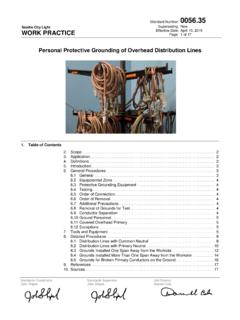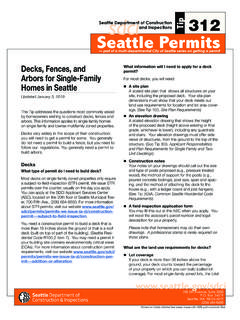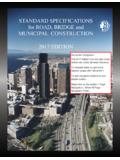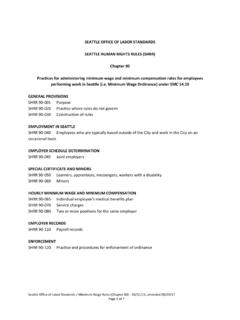Transcription of Residential Small Lot (RSL) - Seattle
1 Residential Small Lot (RSL)CurrentProposedMaximum lot coverage50%Maximum floor area ratio (FAR) height25 feet, or 18 feet for cottages30 feetDensity limit1 unit per 2,500 sq. ft. of lot area1 unit per 2,000 sq. ft. of lot areaSetbacksfrontFront + Rear not less than 30 feet10 feetrearFront + Rear not less than 30 feet10 feetside5 feet5 feetMinimum parking1 per unit; no minimum in urban villages if within quarter-mile of a street with frequent transit service1 per unit; no minimum in urban villages if within quarter-mile of a street with frequent transit serviceMaximum dwelling unit sizeNone2,200 square feetTree planting requirementNonePoint system designed to encourage preservation of existing trees and planting of larger treesPreservation incentiveNone50% of floor area in a preserved existing single-family home is exempt from FARRSL would allow a range of new and remodeled homes compatible in scale and character with existing houses.
2 A maximum height of 30 feet would limit structures in RSL zones to the same height currently allowed in single-family zones. Adding a floor area ratio (FAR) limit of ensures RSL housing is similar in scale to existing development in many single-family-zoned areas. Currently, no FAR limit applies in RSL or single-family zones. A lot coverage limit of 50 percent and front, side, and rear setback requirements would together require new development to include various open space, yards, and planted areas. Infill development under RSL zoning (gold) in an existing single-family context. Table provides a general summary. For complete standards, see proposed legislation at is MHA? Mandatory Housing Affordability (MHA) is a new polcy to ensure growth brings affordability. MHA requires new commercial and multifamily development to include affordable homes or contribute to a City fund for affordable housing.
3 To put MHA into effect, we have proposed zoning changes that add development capacity and increase housing choices in urban villages designated in the Seattle 2035 Comprehensive Plan, certain urban village expansion areas near frequent transit hubs, and other areas with commercial and multifamily zoning. Stand-alone cottage style homes are on a 10,000-square-foot lot. The context is an area formerly zoned single-fam-ily with various existing single-family homes. New homes range in size from 1,050 to 1,800 square feet. Parking is provided on site for three of the units in the rear of the site with access from the alley. Shared open space is provided. The RSL zone would encourage more missing middle housing that is in between the density of Seattle s and single-family and multifamily zones. The RSL zone would result in moderately-sized ownership and rental housing options suitable for families or multi-person households.
4 Historically, the RSL zone has been applied only sparingly in a three-block area of the Madison-Miller Urban Village. MHA implementation would substantially expand the RSL zone to cover more than 767 acres citywide. All areas converted to RSL under the proposed legislation currently have single-family cottage style homes are on a 10,000-square-foot lot. The context is an area formerly zoned single-fam-ily with various existing single-family homes. New homes range in size from 1,050 to 1,800 square feet. Parking is provided on site for three of the units in the rear of the site with access from the alley. Shared open space is provided. A single structure in the scale and character of an older single-family house contains three units, with one home on each of three floors. The lot is 6,000 square feet in size.
5 Each unit is approximately 1,400 square feet. Parking is provided for three cars in a garage at the rear of the lot and in a driveway. This prototype could also represent the conversion of an existing single-family house into three dwelling units without altering the exterior existing single-family home (orange) is retained on a 5,000-square-foot lot, and a new single-family home (white) is added at the rear of the lot. The ex-isting single-family home contains 1,900 square feet, and the new home contains 2,200 square feet. Since 50 percent of the floor area in the preserved home is exempt from the maximum FAR limit, the lot can have slightly more total floor area than would be allowed if the existing home were not preserved. The new home at the rear of the lot is the maximum size allowed for a principal dwelling unit (2,200 square feet).
6 Two parking spaces are provided on site, accessed from the RSL zoneother proposed MHA rezoneWhere are RSL zones proposed?Development examplesCurrentProposedMaximum floor area ratio (FAR) depending on housing height30 feet30 feetDensity limitstownhouses1 unit / 1,600 sq. ft. lot area1 unit / 1,350 sq. ft. lot arearowhouses1 unit / 1,600 sq. ft. lot area1 unit / 1,350 sq. ft. lot areaapartments1 unit / 2,000 sq. ft. lot areano limit family-sized requirement appliesSetbacksfront5 feet minimum, 7 feet average5 feet minimum, 7 feet averagerear10 feet minimum with alley 15 feet minimum if no alley10 feet minimum with alley 15 feet minimum if no alleyside5 feet minimum, 7 feet average5 feet minimum, 7 feet averageFamily-sized housing requirementNone1 family-sized unit required for every 4 housing units builtDesign standardsFront facades must be modulatedFront and side facades must be modulatedMinimum parking 1 per unit; no minimum in urban villages if within a quarter mile of a street with frequent transit service1 per unit; no minimum in urban villages if within a quarter mile of a street with frequent transit service The LR1 zone would continue to encourage townhouses and rowhouses.
7 We also expect some Small apartment buildings to be constructed. Development would be compatible in scale and character to existing LR1-zoned areas, since the height limit and setbacks would not change. We expect a range of home sizes as well as a mix of rental and ownership options. Development in LR1 areas would be similar to, but incrementally greater in scale than, areas with single-family zoning today. New buildings would generally be three stories or fewer. Viewed from neighboring properties or the public right-of-way, new housing in the proposed LR1 zone would not appear dramatically different from housing constructed in the LR1 zone today. We propose new urban design standards for privacy and design interest at side facades. We also propose a new family-sized housing requirement in the LR1 zone, which would require at least one family-sized unit for every four housing units built.
8 Lowrise 1 (LR1)Table provides a general summary. For complete standards, see proposed legislation at is MHA? Mandatory Housing Affordability (MHA) is a new polcy to ensure growth brings affordability. MHA requires new commercial and multifamily development to include affordable homes or contribute to a City fund for affordable housing. To put MHA into effect, we have proposed zoning changes that add development capacity and increase housing choices in urban villages designated in the Seattle 2035 Comprehensive Plan, certain urban village expansion areas near frequent transit hubs, and other areas with commercial and multifamily zoning. About 94 percent (271 acres) of areas currently zoned LR1 would retain an LR1 zoning designation and receive a development capacity increase through the new development standards.
9 In addition, about 297 acres of land currently zoned single-family would be converted to the proposed LR1 zone. As a result, the proposed legislation would more than double the amount of land zoned LR1, which accommodates missing middle housing types like rowhouses and townhouses. Required family-sized homes would have to be at least 850 square feet and have two or more bedrooms. A builder may substitute one unit that is at least 1,050 square feet and has three bedrooms for two 850-square-foot units. The same height limit would apply for development in LR1 zones and that applies in single-family zones today. Infill development (gold) in a Lowrise 1 zone. The left side of the street is an existing sin-gle-family-zoned context. The right side of the street is an existing Lowrise 1 zone context. Four townhouse units are constructed on a 5,300-square-foot lot.
10 Each three-story town-house is about 1,725 square feet in size. The lower density limit allows one more townhouse than could be built on the lot under current LR1 rules. The example includes three parking spaces at grade, accessed from the alley at the rear of the site. The context is a mix of existing townhouses and rowhouses in the LR1 zone. New homes are similar in height to other exist-ing structures since we propose no change to the current 30-foot height limit for LR1 zones. An apartment building with 20 homes is con-structed on a 10,000-square-foot lot. Sixteen units are 550-square-foot one-bedroom units. Four units are two- and three-bedroom fam-ily-sized units of 850 square feet due to the family-sized housing requirement. Three sto-ries are above grade, and some additional res-idential floor area is in a partially below-grade story.
